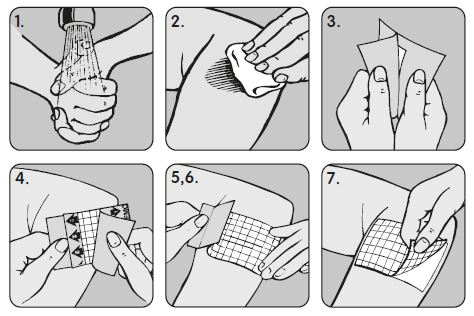OPSITE◊ FLEXIGRID◊
Transparent Film Dressing


| Sizes | Dressings per pack |
| 6cm x 7cm | 5 dressings |
| 10cm x 12cm | 10 dressings |

1. Smith+Nephew 2012. OPSITE Flexigrid Dressing Physical Properties. Internal Report. DS/12/214/DOF.
2. Smith+Nephew 2008. A double blind, randomised, prospective, within volunteer comparison of two new film variants and control product for both Flexigrid and Flexifix. Internal Report. VTR/HVT037_ST737.
3. Smith+Nephew 2018. Low allergy adhesive claims support for OPSITE Flexigrid. Internal Report.
4. Demirtas Y, Yagmur C, Soylemez F, Ozturk N, Demir A. Management of split-thickness skin graft donor site: A prospective clinical trial for comparison of five different dressing materials. Burns. 2010;36(7):999-1005.
5. Smith+Nephew 2004. Bacterial Barrier Testing of Extruded Flexigrid and Flexifix Dressing. WRP-TW042-399.
6. Smith+Nephew 2008. Bacterial Barrier (wet:wet) on samples of OPSITE dressings. TSG018-07-008 V2.
7. Vejdan SA, Khosravi M, Zojaji F. Burn Donor Site Dressing Using Melolin and Flexigrid Versus Conventional Dressing. Shiraz E-Medical Journal. 2015;16(1).
8. Smith+Nephew 1990. A community based clinical evaluation of standard OPSITE film dressing compared with a new presentation OPSITE film dressing. Internal Report. CTR/88/11.
9. Smith+Nephew 2020. Simulated use test of OPSITE Flexigrid. Internal Report. W07309/R1.
10. Smith+Nephew 2019. Use of Moisture Vapour Permeability* (MVP) and Moisture Vapour Transmission Rate** (MVTR) data to support product claims referring to moist wound healing. Internal Report. EO.AWM.PCSgen.001.v2
11. Läuchli S, Hafner J, Ostheeren S, Mayer D, Barysch MJ, French LE. Management of split-thickness skin graft donor sites: A randomized controlled trial of calcium alginate versus polyurethane film dressing. Dermatology. 2014;227(4):361-366.
12. Smith+Nephew 2007. A double blind, randomised, prospective, within volunteer comparison of OPSITE FLEXIGRID and Incise dressings with A8 adhesive or novel adhesives. Internal Report. VTSR/HVT024_ST666 (Critical Data Report).